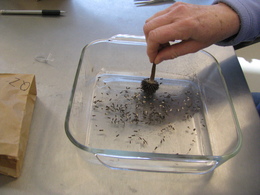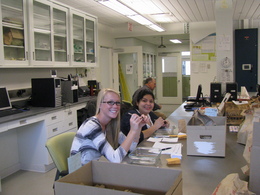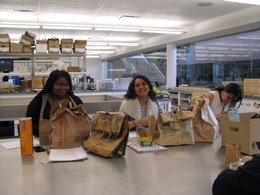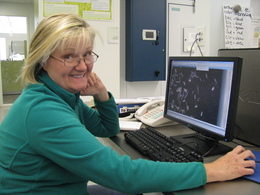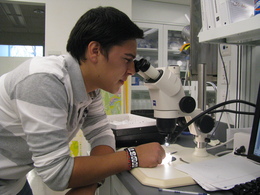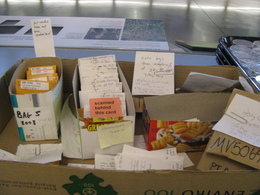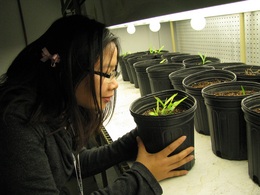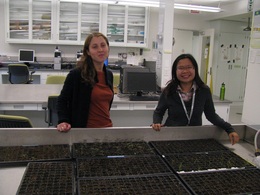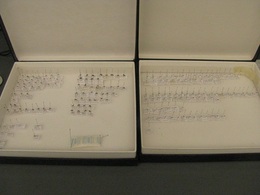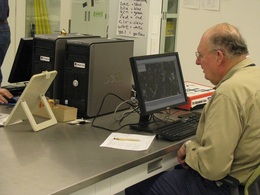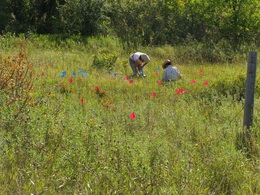|
|
As you can see in this lovely motivational diagram, we finally finished counting last year’s achenes from the 1999 experimental plot.

The next step for this batch will be to collect a random sample of achenes from each flower head to estimate pollination rates. We can tell whether an achene is “full” (contains an embryo) or “empty” (does not contain an embryo) based on its weight. We can estimate pollination rates based on the ratio of full and empty achenes. However, there are some achenes whose weight does not give us any information about pollination. Some are so small they never produce an embryo, some are damaged by insects, some are damaged during removal from the flower head, etc. If we weighed these, they would show up as “empty”, even though they may have been pollinated. Therefore. when we select a random achenes for weighing, we have to differentiate between those that are informative about the pollination environment (full or empty) and those that are not informative (small, sterile, damaged, etc.).
For this batch, we are starting a new randomization protocol that assigns achenes to categories of “informative” (possibly full or definitely empty) and “uninformative” (sterile, undersized, damaged). Both are part of the random sample, but only the informative achenes are weighed. It’s a subtle distinction from what we were doing before, but it will be important for our results.
Now that we have reached our goal in counting, we have started processing the heads we harvested in 2012. Today volunteers Katharine and Sam are trying out a new protocol for removing the achenes from Echinacea heads. Previously, we through away any dust left over from removing achenes. This time, we are saving the dust in separate envelopes. That way, we will be able to figure out whether the dust we throw away contains fragments of achenes. Also, we will be able to compare scans with and without the extra dust to see whether removing dust makes a difference in the accuracy of our count data.

We had a lot of people in the lab last week. On Wednesday, we had volunteers Kathryn Eber and Sam Goldman along with a group of interns from Lakeforest College:



The Lakeforest students will return for two more afternoons–or longer if they so choose.
In other news, we are nearly finished counting the seeds from the 4000s batch in the 2011 harvest. For this batch, we are trying out a new protocol for selecting a random sample of seeds to weigh. Volunteers Suzie and Susanne were the first to implement the protocol and have given us some good feedback.
This week has brought us further along on our goal of counting and randomizing all of the achenes from 2011. Here is volunteer Kathryn Eber, looking pleased to have her picture taken. Thanks to her and the other volunteers, we are nearly finished counting the 4000 batch of the 2011 harvest.

On Wednesday October 31st, we welcomed several students from Lakeforest College for the first session of a four week internship. Meet Randen, who is working with me to learn how to identify ants:

When he came in, he had no experience identifying insects or using taxonomic keys. By the time he left, he was able to identify ants to genus and–for some genera–to species. His project is to compare ant species collected from burned and unburned units of the Staffenson prairie preserve. Ants are a crucial component to terrestrial ecosystems: they move dirt, they prey on many critters, and they protect other critters like aphids. If fire influences the community of ant species in a prairie remnant, there may be cascading effects throughout the ecosystem. Naturally, I’m excited to see what Randen finds out during his project.
Every year the Echinacea Project collects all of the flowering heads from the experimental plots and processes them in the lab. Considering this process managed and completed by different people every year, it is challenging to keep everything organized from year to year.
One of our goals this year is to wrap up data collection on Echinacea seed heads from 2009 to 2011. Last year, Northwestern students Karen Taira and Ricky Rivera spent many hours organizing data from 2009 and 2010. They solved a lot of mysteries, including mislabeled heads, mislabeled files, and files saved in weird places. Last week I picked up where they left off. We are down to one box of mysteries–seeds that still need to be scanned, counted, and weighed. Once we finish with this box, we will have all our data from 2009.

In other news, a class from Lakeforest College is coming to the Chicago Botanic Garden for a mini-internship program. Karen, Stuart, and I will all be mentoring students for the next few weeks in projects related to our research. We will introduce the students and update their progress on the flog.
Lastly, this week we said goodbye to volunteer Art Abt as he prepared for his winter migration to warmer climes. We will miss him and his expertise in seed weighing.
Based on the flog, it may seem that the lab activity has been consumed with counting seeds and identifying ants. However, I should point out that there are some real live plants in the lab as well.
Maria has been lovingly tending her Dicanthelium plants that she germinated last fall. One of the perks of working at the Chicago Botanic Garden is the high-tech growth chamber that allows you to control light, temperature, and humidity on a programmed schedule. Maria has programmed the chamber to approximate fall in Minnesota.

Any one at CBG can use the growth chamber for their research. Anna Braum, a grad student at Northwestern, is growing host plants for her experiment on the parasitic plant Castilleja coccinea–also known as the indian paintbrush. Here she is watering her plants (with help from Maria).

We made a lot of progress this week. First, the volunteers finished the first round of counting for one of the larger experimental plots. There are still two more rounds of counting to finish, but we’re mostly there.
Suzanne started taking inventory of the heads we harvested this year. It didn’t take her long to get through everything, considering flowering was so low this year. Out of about 500 heads, there was only one that was mislabeled. There were a few missing, but they are on their way back from Minnesota.

I’ve been busy trying to identify all the ant specimens we have pinned. Right now it looks like we have two species of Lasius, five species of Formica, and one species each in several other genera. There are also multiple species within the genus Myrmica, but I haven’t identified them yet. Apparently that genus is particularly difficult to identify.
This summer, REU student Jill Gall put together a large collection of ants from prairie remnants in Minnesota. Yesterday, Stuart and I headed over to Lakeforest College to seek the advice of resident ant ecologist Sean Menke. Jill left us with two boxes of ants, which she pinned and identified to genus and separated into morphotypes:

Sean was impressed with her identification skills: she was correct in nearly every identification to genus and many of her morphotypes were consistent. He gave us some tips on what traits to look for when identifying ants. Now we have a plan for going through the rest of the collection. This will allow us to compare the species diversity of ants among prairie remnants, and hopefully pave the way for future ant research in the lab.

Now that the summer field season has come to an end, it is time to focus on what’s going on in the lab at the Chicago Botanic Gardens. I am taking over for Josh as lab manager and have spent most of the week learning my way around the lab.
Since I arrived, the two major tasks for the volunteers have been counting, randomizing, and weighing achenes from heads collected in 2011.
Here is Aldo, using the computer to count achenes from a scanned image:

Once we have a count of achenes for each head, we select a random sample for weighing. Here is Char, randomizing achenes based on a numbered grid:

As for the 2012 harvest, we brought a little over 500 heads from the main experimental plot. This is much less than the 2890 heads collected last year. Our haul from this year also includes heads from Kelly’s phenology study, heads from Shona’s hybridization experiment, and a sizable collection of ants from prairie remnants. We have plenty of work in store for the coming months.
It’s quiet in the town hall. After Kelly and Jill left on Saturday, Maria and I had the place all to ourselves. We decided to use our Sunday to make a dent in the Echinacea Project to-do list.
First, we completed seedling refinds at three small sites (NWLF, NNWLF, and SGC) and made it a third of the way through a fourth (NESS). We also completed demography rechecks at Woody’s. This entails reconciling errors from this year’s census and collecting data on plants that flowered last year.
Woody’s happens to be one of Maria’s favorite sites. Notice the joy:

The past couple of days have been lovely for outdoor work–sunny, cool, a little breezy. On Monday we said bon voyage to the Wagenius family as they prepared for their trip back to Chicagoland. Stuart will be back next week, but Gretel and the kids are done for the summer. Now there are five of us and no shortage of work to do.
Monday morning we went to the site off of hwy 27 to take demography data on plants that flowered last year and reconcile errors from this year’s demography census. With two teams working with the GRS-1 GPS units, the task went quickly and smoothly.
We spent Monday afternoon re-finding seedlings at KJ’s. This is a particularly challenging site because there is a high density of plants in a small area. We continued the endeavor this morning, and I’m happy to say are nearly finished. We should be able to defeat the beast tomorrow morning.
Here are Jill and Maria looking for seedlings at KJ’s. Red flags mark completed focal plants.

This afternoon we performed some routine maintenance of the main experimental plot, pulling out flags that marked plant we could not find. Then we spent the rest of the afternoon on individual projects.
Karen Taira, who came up last week, has been spending her days working on her pollination experiment involving several species of Helianthus. Her field story of the day was that she found a pile of entrails next to one of her experimental plants. Apparently they were bigger than a prairie dog’s and smaller than a human’s. Perhaps it’s a new form of sacrificial sun worship–Praise Helianthus!
|
|


